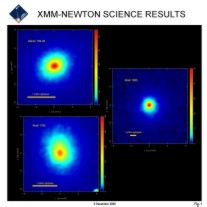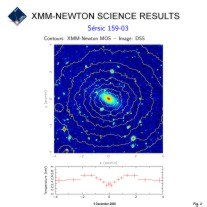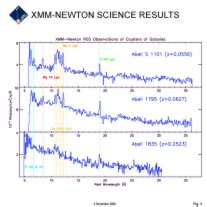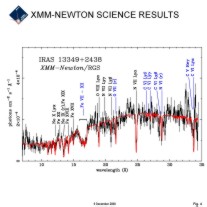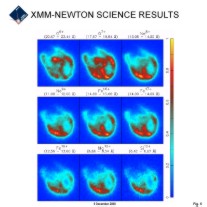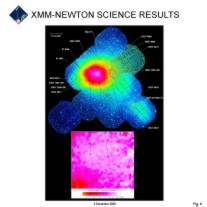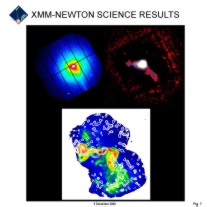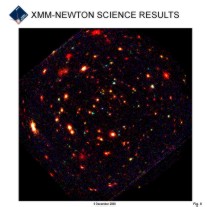XMM-Newton First Science Results - XMM-Newton
XMM-Newton First Science Results
This page provides the set of XMM-Newton Science Results as presented on December 6, 2000 during the Launch Anniversary Press Conference at ESA HQ, Paris.
From here you can:
-
View the set of presented images:
- Fig. 1 - Cluster of galaxies (I)
- Fig. 2 - Abell S 1101
- Fig. 3 - Cluster of galaxies (II)
- Fig. 4 - IRAS 13349+2438
- Fig. 5 - Supernova remnant N132D
- Fig. 6 - Coma Cluster
- Fig. 7 - M87
-
Fig. 8 - Lockman Hole
- Read and/or download the set of Astronomy & Astrophysics papers to be published in a forthcoming Special Issue.
PRESENTED IMAGES AT THE XMM-Newton PRESS CONFERENCE
(Click on an image to get it in full size)
Back to top
Back to top
Back to top
Back to top
Back to top
Back to top
Back to top
Back to top
XMM-Newton A&A Papers (Special Issue)
All available papers are in both ps and pdf (Acrobat 4) format.
| First Author | Title |
Available Formats |
||
| J. Cottam | High-Resolution Spectroscopy of the low mass X-Ray Binary EXO0748-67 | ps | ||
| G. Ramsay | First XMM-Newton observations of a cataclysmic variable I : Timing Studies of OY Car | ps | ||
| G. Ramsay | First XMM-Newton observations of a cataclysmic variable II : The X-ray spectrm of OY Car | ps | ||
| P.T. O'Brien | XMM-Newton detection of a comptonized accretion disc in the quasar PKS0558-504 | ps | ||
| M. Cropper | Modelling the spin pulse profile of the isolated neutron star RXJ0720.4-3125 observed with XMM-Newton | ps | ||
| J.N. Reeves | XMM-Newton observation of an unusual iron line in the quasar Markarian 205 | ps | ||
| D.M. Neumann | The NGC4839 group falling onto the Coma Cluster observed by XMM-Newton | ps | ||
| F. Haberl | AGN in the XMM-Newton fisrt light image as probes for the interstellar medium in the LMC | ps | ||
| W. Pietsch | XMM-Newton observations of NGC 253 : resolving the emission components in the disk and nuclear area | ps | ||
| J.W. den Herder | The reflection grating spectrometer on board XMM-Newton | ps | ||
| G. Hasinger | XMM-Newton observation of the Lockman Hole | ps | ||
| M. Guedel | The XMM-Newton view of stellar coronae : Coronal structure in the Castor X-ray triplet | ps | ||
| Th. Boller | XMM-Newton observations of the BL Lac MS0737+7441 | ps | ||
| M. Sako | Complex resonance absorption structure in the X-ray spectrum of IRAS13349+2438 | ps | ||
| E. Behar | High resolution X-ray spectroscopy and imaging of supernova remnant N132D | ps | ||
| J.N. Reeves | The first XMM-Newton spectrum of a high redshift quasar - PKS0537-286 | ps | ||
| R. Willingale | New light on the X-ray spectrum of the Crab Nebula | ps | ||
| S.M. Kahn | High resolution X-ray spectroscopy of zeta-Puppis with the XMM-Newton reflection grating spectrometer | ps | ||
| M. Sasaki | XMM-Newton EPIC observation of SMC SNR 0102-72.3 | ps | ||
| M. Audard | The XMM-Newton view of stellar coronae : Flare heating in the coronae of HR1099 | ps | ||
| M. Audard | The XMM-Newton view of stellar coronae : High-Resolution X-ray spectroscopy of Capella | ps | ||
| W. Brinkmann | XMM-Newton observations of Mkn 421 | ps | ||
| S. Sciortino | XMM-Newton survey of the low-metallicity open cluster NGC 2516 | ps | ||
| M. Arnaud | Measuring cluster temperature profiles with XMM/Epic | ps | ||
| M. Arnaud | XMM-Newton observation of the coma galaxy cluster | ps | ||
| K.O. Mason | The XMM-Newton Optical/UV monitor telescope | ps | ||
| M. Watson | The XMM-Newton seredipitous survey. (I) The role of the XMM-Newton Survey Science Centre | ps | ||
| M. Guedel | The XMM-Newton view of stellar coronae : X-ray spectroscopy of the corona of AB Doradus | ps | ||
| J.P.D. Mittaz | UV observations of the galaxy cluster Abell 1795 with the optical monitor on XMM-Newton | ps | ||
| L. Strueder | The European Photon Imaging Camera on XMM-Newton : The pn-CCD camera | ps | ||
| J.S. Kaastra | XMM-Newton observations of the cluster of galaxies Sersic 159-03 | ps | ||
| A.C. Brinkman | First light measurements with the XMM-Newton Reflection Grating Spectrometers : Evidence for an inverse first ionization potential effect and anomalous Ne abundance in the Coronae of HR1099 | ps | ||
| F. Jansen | XMM-Newton observatory I The spacecraft and operations | ps | ||
| R.S. Warwick | The extended X-ray halo of the Crab like SNR G21.5-0.9 | ps | ||
| Th. Boller | Detection of an X-ray periodicity in the narrow line Seyfert galaxy Mrk 766 with XMM-Newton | ps | ||
| M.J. Page | The variable XMM-Newton X-ray spectrum of Markarian 766 | ps | ||
| G. Branduardi | Soft X-ray emission lines from a relativistic accretion disk in MCG-6-30-15 and Mrk 766 | ps | ||
| F. Paerels | A high resolution spectroscopic observation of CAL 83 with XMM-Newton/RGS | ps | ||
| F. Paerels | First XMM-Newton observations of an isolated Neutron star: RXJ 0720.4-3125 | ps | ||
| T. Tamura | X-ray spectroscopy of the Cluster of Galaxies Abell 1795 with XMM-Newton | ps | ||
| K.J. van der Heyden | Detection of X-ray line emission from the shell of SNR B0540-69.3 with XMM-Newton RGS | ps | ||
| A. Rasmussen | The X-ray spectrum of the supernova remnant 1E0102-72.3 | ps | ||
| M.J.L. Turner | The European Photon Imaging Camera on XMM-Newton: The MOS Cameras | ps | ||
| A. Decourchelle | XMM-Newton observation of the Tycho Supernova Remnant | ps | ||
| H. Boehringer | XMM-Newton observations of M87 and its X-ray halo | ps | ||
| E. Belsole | An XMM-Newton study of the sub-structure in the M87's halo | ps | ||
| J. Peterson | X-Ray imaging spectroscopy of Abell 1835 | ps | ||
| U. Briel | A mosaic of the Coma Cluster of galaxies with XMM-Newton | ps | ||
| J.M.A. Bleeker | Cassiopeia A : On the origin of the hard X-ray continuum and the implication of the observed OVIII Ly-alpha/Ly-Beta distribution | ps | ||
| R. Shirey | The central region of M31 observed with XMM-Newton I : Group properties and diffuse emission | ps | ||
| J.M. Bonnet-Bidaud | The eclipsing bursting X-ray binary EXO 0748-676 revisited by XMM-Newton | ps | ||
| M.J.L. Turner | XMM-Newton first light observations of the Hickson Galaxy Group 16 | ps | ||
| K. Dennerl | The first broad band X-ray images and spectra of the 30 Doradus region in the LMC | ps | ||
| K. Wu | XMM-Newton and EPIC and RGS observations of LMC X-3 | ps | ||
| R. Soria | XMM-Newton Optical Monitor observations of LMC X-3 | ps | ||
| M. Gliozzi | XMM-Newton monitoring of X-ray variability in the quasar PKS 0558-504 | ps | ||
- Removed a total of (1) style text-align:center;
- Removed a total of (2) style text-align:left;
- Removed a total of (113) align=center.
- Removed a total of (57) align=left.
- Removed a total of (9) border attribute.
- Converted a total of (2) center to div.








































 Sign in
Sign in
 Science & Technology
Science & Technology
